Behavior Change using Transtheoretical Model and Motivational Interviewing
VerifiedAdded on 2022/11/01
|9
|2690
|78
AI Summary
This paper discusses the essence of behavior change using the transtheoretical model of change to elaborate on the stages of behavior change. It also describes the essence of the motivational interview in behavior change and outlines the benefits and limitations of the same.
Contribute Materials
Your contribution can guide someone’s learning journey. Share your
documents today.
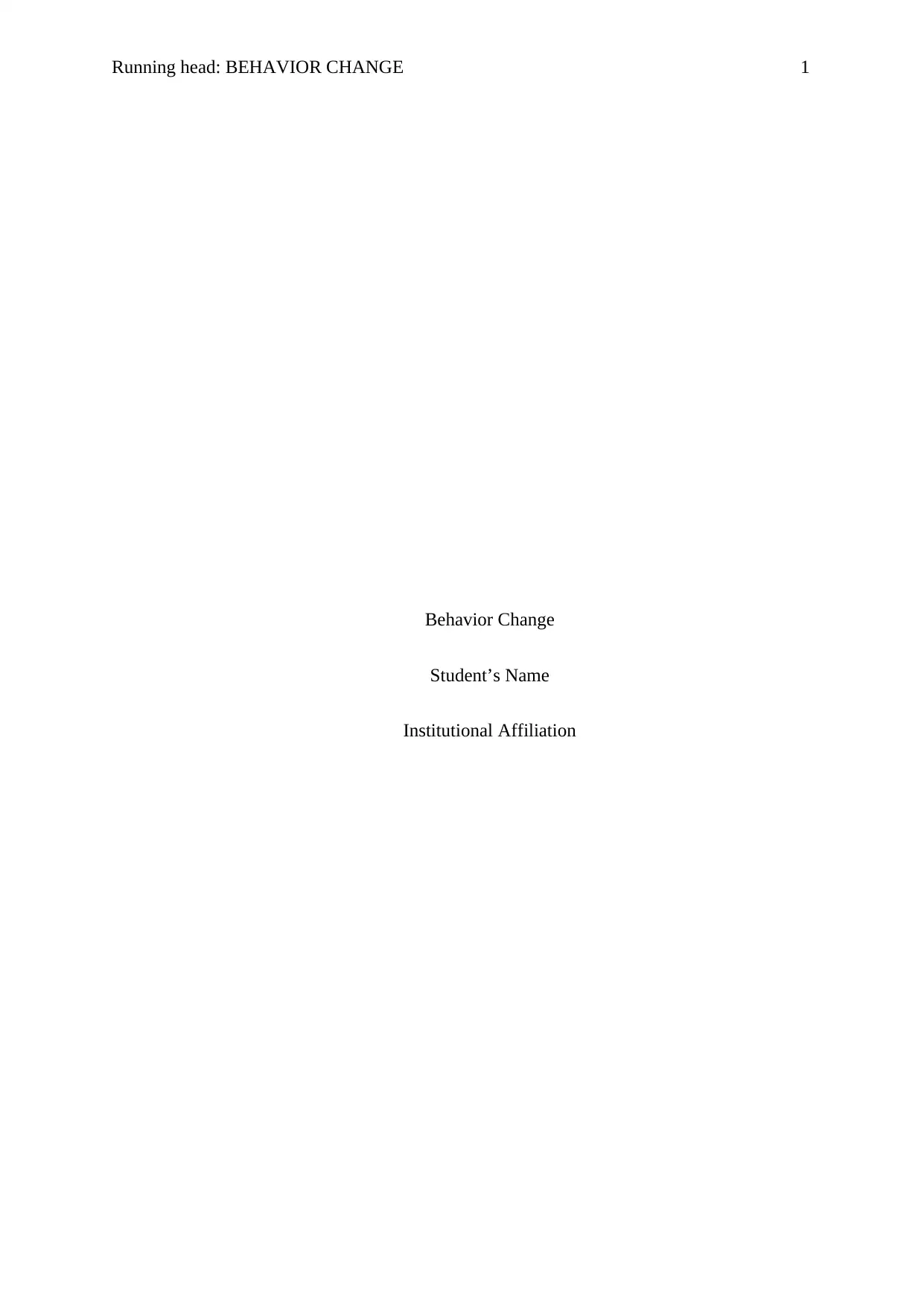
Running head: BEHAVIOR CHANGE 1
Behavior Change
Student’s Name
Institutional Affiliation
Behavior Change
Student’s Name
Institutional Affiliation
Secure Best Marks with AI Grader
Need help grading? Try our AI Grader for instant feedback on your assignments.
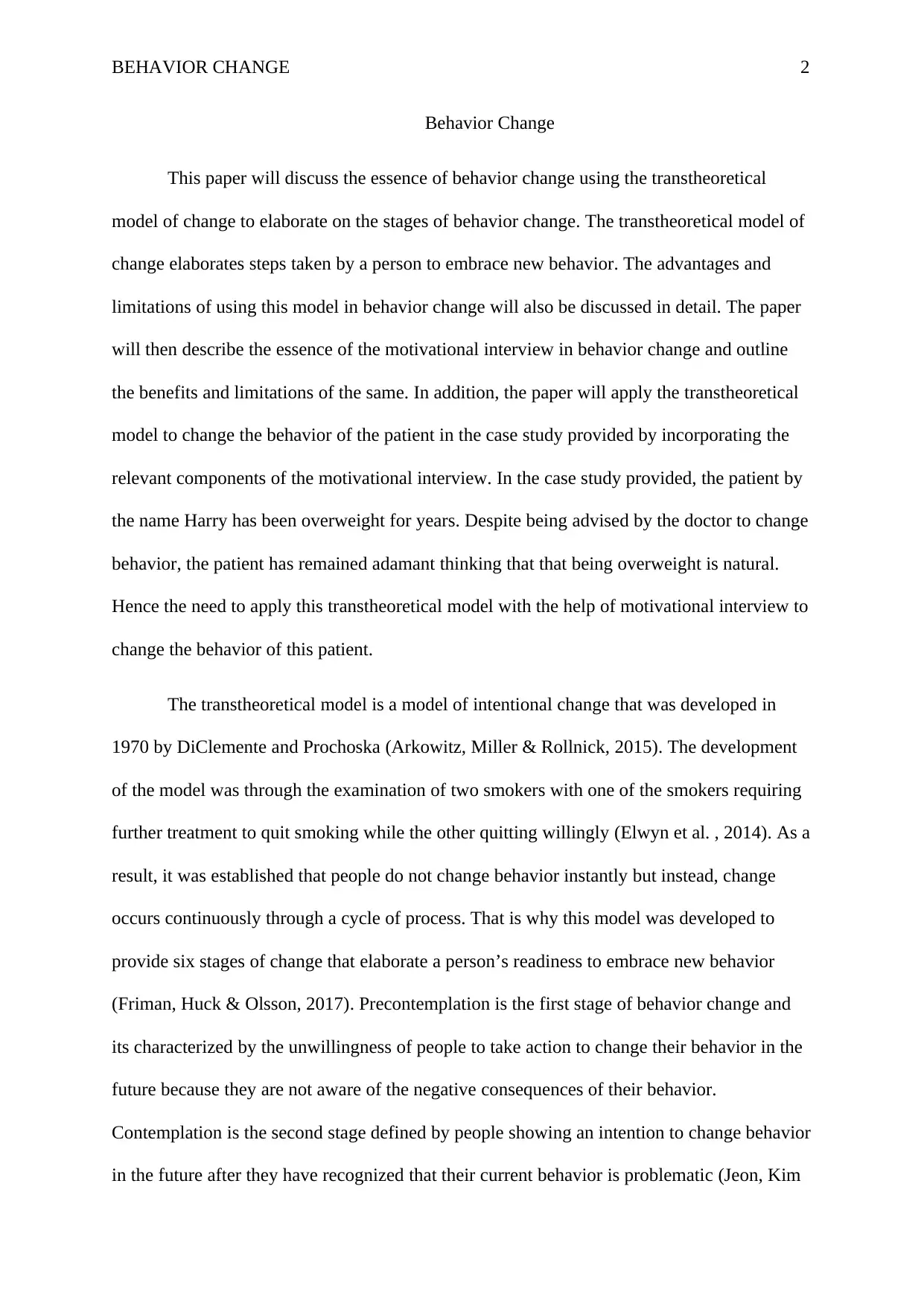
BEHAVIOR CHANGE 2
Behavior Change
This paper will discuss the essence of behavior change using the transtheoretical
model of change to elaborate on the stages of behavior change. The transtheoretical model of
change elaborates steps taken by a person to embrace new behavior. The advantages and
limitations of using this model in behavior change will also be discussed in detail. The paper
will then describe the essence of the motivational interview in behavior change and outline
the benefits and limitations of the same. In addition, the paper will apply the transtheoretical
model to change the behavior of the patient in the case study provided by incorporating the
relevant components of the motivational interview. In the case study provided, the patient by
the name Harry has been overweight for years. Despite being advised by the doctor to change
behavior, the patient has remained adamant thinking that that being overweight is natural.
Hence the need to apply this transtheoretical model with the help of motivational interview to
change the behavior of this patient.
The transtheoretical model is a model of intentional change that was developed in
1970 by DiClemente and Prochoska (Arkowitz, Miller & Rollnick, 2015). The development
of the model was through the examination of two smokers with one of the smokers requiring
further treatment to quit smoking while the other quitting willingly (Elwyn et al. , 2014). As a
result, it was established that people do not change behavior instantly but instead, change
occurs continuously through a cycle of process. That is why this model was developed to
provide six stages of change that elaborate a person’s readiness to embrace new behavior
(Friman, Huck & Olsson, 2017). Precontemplation is the first stage of behavior change and
its characterized by the unwillingness of people to take action to change their behavior in the
future because they are not aware of the negative consequences of their behavior.
Contemplation is the second stage defined by people showing an intention to change behavior
in the future after they have recognized that their current behavior is problematic (Jeon, Kim
Behavior Change
This paper will discuss the essence of behavior change using the transtheoretical
model of change to elaborate on the stages of behavior change. The transtheoretical model of
change elaborates steps taken by a person to embrace new behavior. The advantages and
limitations of using this model in behavior change will also be discussed in detail. The paper
will then describe the essence of the motivational interview in behavior change and outline
the benefits and limitations of the same. In addition, the paper will apply the transtheoretical
model to change the behavior of the patient in the case study provided by incorporating the
relevant components of the motivational interview. In the case study provided, the patient by
the name Harry has been overweight for years. Despite being advised by the doctor to change
behavior, the patient has remained adamant thinking that that being overweight is natural.
Hence the need to apply this transtheoretical model with the help of motivational interview to
change the behavior of this patient.
The transtheoretical model is a model of intentional change that was developed in
1970 by DiClemente and Prochoska (Arkowitz, Miller & Rollnick, 2015). The development
of the model was through the examination of two smokers with one of the smokers requiring
further treatment to quit smoking while the other quitting willingly (Elwyn et al. , 2014). As a
result, it was established that people do not change behavior instantly but instead, change
occurs continuously through a cycle of process. That is why this model was developed to
provide six stages of change that elaborate a person’s readiness to embrace new behavior
(Friman, Huck & Olsson, 2017). Precontemplation is the first stage of behavior change and
its characterized by the unwillingness of people to take action to change their behavior in the
future because they are not aware of the negative consequences of their behavior.
Contemplation is the second stage defined by people showing an intention to change behavior
in the future after they have recognized that their current behavior is problematic (Jeon, Kim
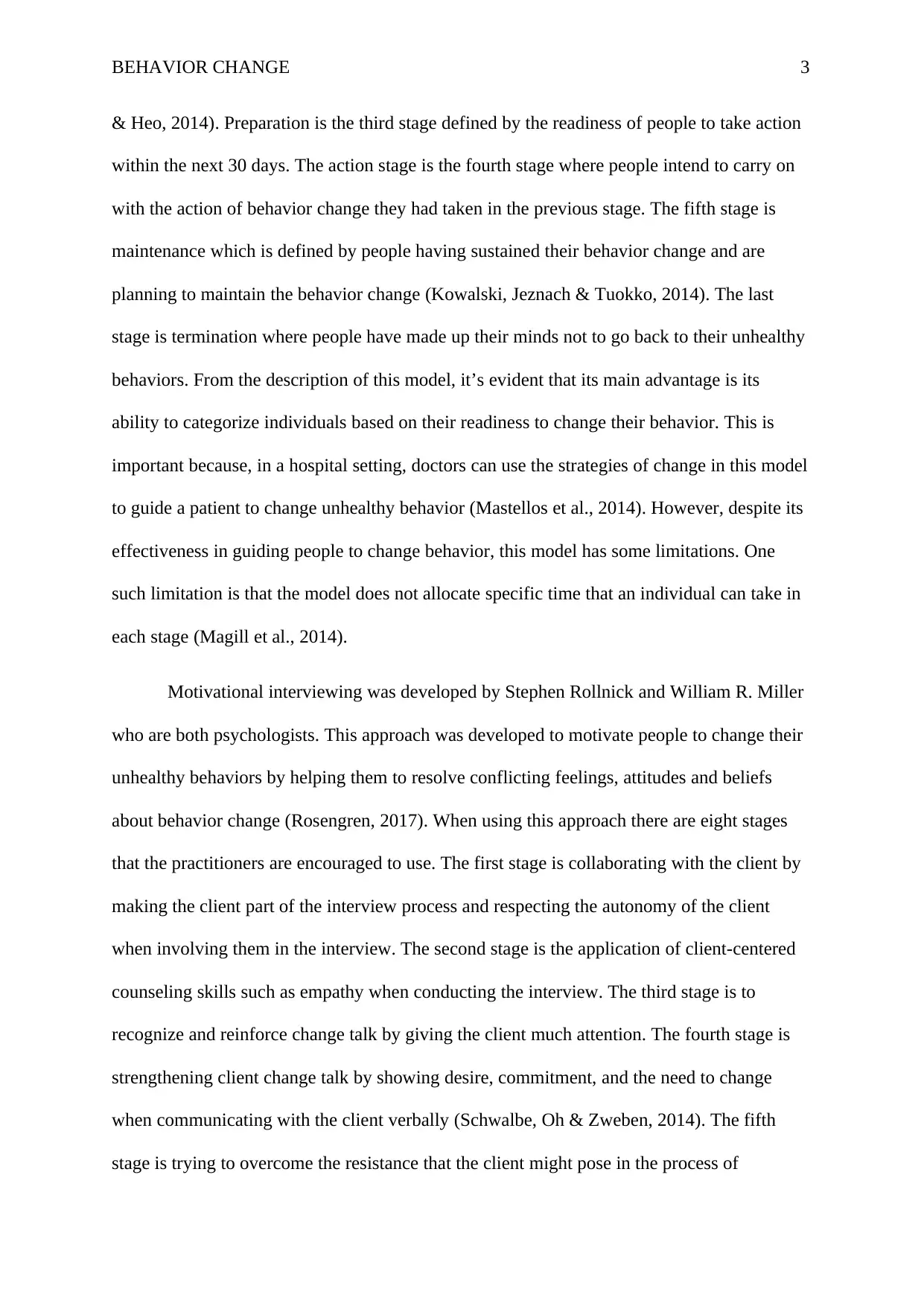
BEHAVIOR CHANGE 3
& Heo, 2014). Preparation is the third stage defined by the readiness of people to take action
within the next 30 days. The action stage is the fourth stage where people intend to carry on
with the action of behavior change they had taken in the previous stage. The fifth stage is
maintenance which is defined by people having sustained their behavior change and are
planning to maintain the behavior change (Kowalski, Jeznach & Tuokko, 2014). The last
stage is termination where people have made up their minds not to go back to their unhealthy
behaviors. From the description of this model, it’s evident that its main advantage is its
ability to categorize individuals based on their readiness to change their behavior. This is
important because, in a hospital setting, doctors can use the strategies of change in this model
to guide a patient to change unhealthy behavior (Mastellos et al., 2014). However, despite its
effectiveness in guiding people to change behavior, this model has some limitations. One
such limitation is that the model does not allocate specific time that an individual can take in
each stage (Magill et al., 2014).
Motivational interviewing was developed by Stephen Rollnick and William R. Miller
who are both psychologists. This approach was developed to motivate people to change their
unhealthy behaviors by helping them to resolve conflicting feelings, attitudes and beliefs
about behavior change (Rosengren, 2017). When using this approach there are eight stages
that the practitioners are encouraged to use. The first stage is collaborating with the client by
making the client part of the interview process and respecting the autonomy of the client
when involving them in the interview. The second stage is the application of client-centered
counseling skills such as empathy when conducting the interview. The third stage is to
recognize and reinforce change talk by giving the client much attention. The fourth stage is
strengthening client change talk by showing desire, commitment, and the need to change
when communicating with the client verbally (Schwalbe, Oh & Zweben, 2014). The fifth
stage is trying to overcome the resistance that the client might pose in the process of
& Heo, 2014). Preparation is the third stage defined by the readiness of people to take action
within the next 30 days. The action stage is the fourth stage where people intend to carry on
with the action of behavior change they had taken in the previous stage. The fifth stage is
maintenance which is defined by people having sustained their behavior change and are
planning to maintain the behavior change (Kowalski, Jeznach & Tuokko, 2014). The last
stage is termination where people have made up their minds not to go back to their unhealthy
behaviors. From the description of this model, it’s evident that its main advantage is its
ability to categorize individuals based on their readiness to change their behavior. This is
important because, in a hospital setting, doctors can use the strategies of change in this model
to guide a patient to change unhealthy behavior (Mastellos et al., 2014). However, despite its
effectiveness in guiding people to change behavior, this model has some limitations. One
such limitation is that the model does not allocate specific time that an individual can take in
each stage (Magill et al., 2014).
Motivational interviewing was developed by Stephen Rollnick and William R. Miller
who are both psychologists. This approach was developed to motivate people to change their
unhealthy behaviors by helping them to resolve conflicting feelings, attitudes and beliefs
about behavior change (Rosengren, 2017). When using this approach there are eight stages
that the practitioners are encouraged to use. The first stage is collaborating with the client by
making the client part of the interview process and respecting the autonomy of the client
when involving them in the interview. The second stage is the application of client-centered
counseling skills such as empathy when conducting the interview. The third stage is to
recognize and reinforce change talk by giving the client much attention. The fourth stage is
strengthening client change talk by showing desire, commitment, and the need to change
when communicating with the client verbally (Schwalbe, Oh & Zweben, 2014). The fifth
stage is trying to overcome the resistance that the client might pose in the process of
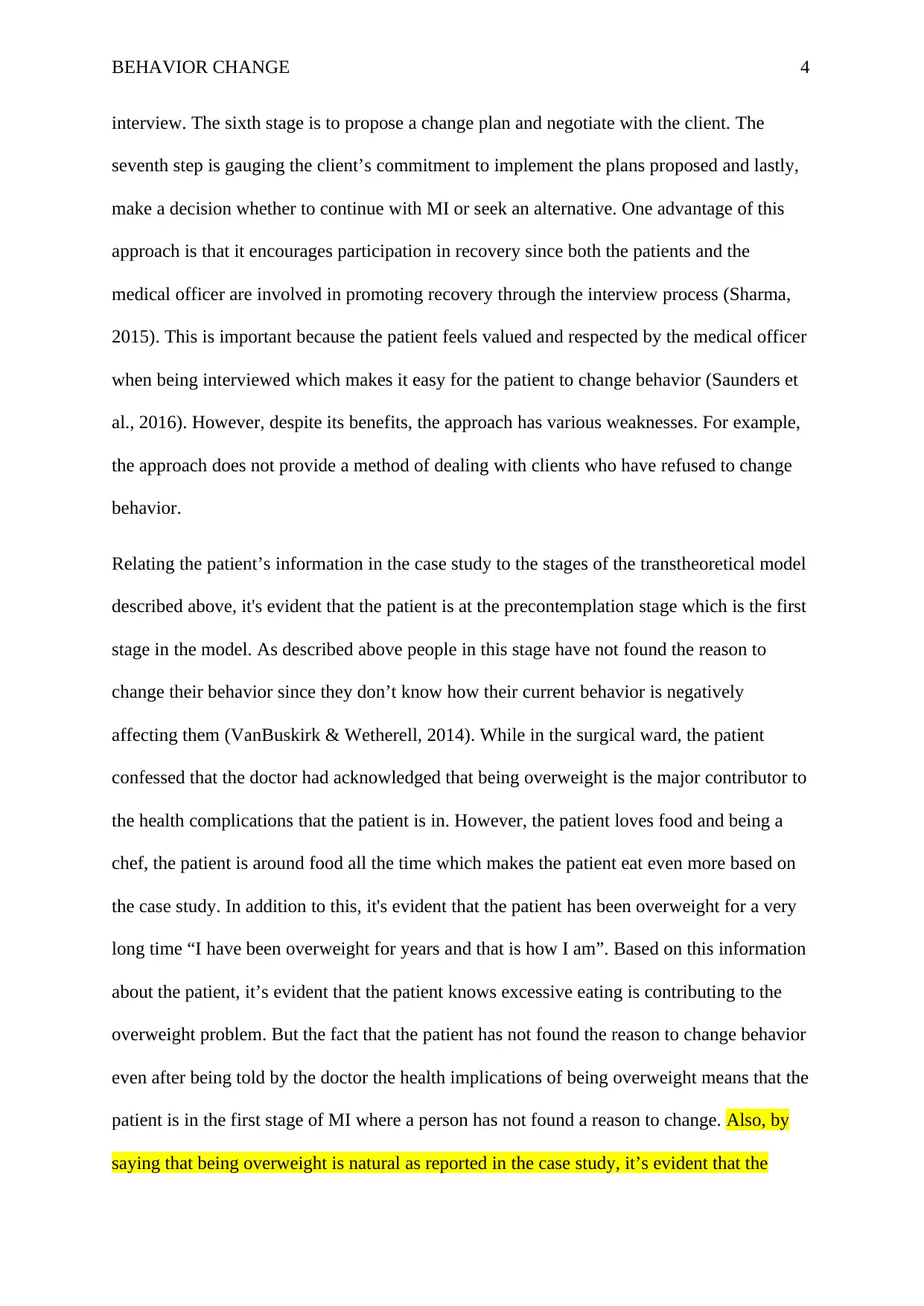
BEHAVIOR CHANGE 4
interview. The sixth stage is to propose a change plan and negotiate with the client. The
seventh step is gauging the client’s commitment to implement the plans proposed and lastly,
make a decision whether to continue with MI or seek an alternative. One advantage of this
approach is that it encourages participation in recovery since both the patients and the
medical officer are involved in promoting recovery through the interview process (Sharma,
2015). This is important because the patient feels valued and respected by the medical officer
when being interviewed which makes it easy for the patient to change behavior (Saunders et
al., 2016). However, despite its benefits, the approach has various weaknesses. For example,
the approach does not provide a method of dealing with clients who have refused to change
behavior.
Relating the patient’s information in the case study to the stages of the transtheoretical model
described above, it's evident that the patient is at the precontemplation stage which is the first
stage in the model. As described above people in this stage have not found the reason to
change their behavior since they don’t know how their current behavior is negatively
affecting them (VanBuskirk & Wetherell, 2014). While in the surgical ward, the patient
confessed that the doctor had acknowledged that being overweight is the major contributor to
the health complications that the patient is in. However, the patient loves food and being a
chef, the patient is around food all the time which makes the patient eat even more based on
the case study. In addition to this, it's evident that the patient has been overweight for a very
long time “I have been overweight for years and that is how I am”. Based on this information
about the patient, it’s evident that the patient knows excessive eating is contributing to the
overweight problem. But the fact that the patient has not found the reason to change behavior
even after being told by the doctor the health implications of being overweight means that the
patient is in the first stage of MI where a person has not found a reason to change. Also, by
saying that being overweight is natural as reported in the case study, it’s evident that the
interview. The sixth stage is to propose a change plan and negotiate with the client. The
seventh step is gauging the client’s commitment to implement the plans proposed and lastly,
make a decision whether to continue with MI or seek an alternative. One advantage of this
approach is that it encourages participation in recovery since both the patients and the
medical officer are involved in promoting recovery through the interview process (Sharma,
2015). This is important because the patient feels valued and respected by the medical officer
when being interviewed which makes it easy for the patient to change behavior (Saunders et
al., 2016). However, despite its benefits, the approach has various weaknesses. For example,
the approach does not provide a method of dealing with clients who have refused to change
behavior.
Relating the patient’s information in the case study to the stages of the transtheoretical model
described above, it's evident that the patient is at the precontemplation stage which is the first
stage in the model. As described above people in this stage have not found the reason to
change their behavior since they don’t know how their current behavior is negatively
affecting them (VanBuskirk & Wetherell, 2014). While in the surgical ward, the patient
confessed that the doctor had acknowledged that being overweight is the major contributor to
the health complications that the patient is in. However, the patient loves food and being a
chef, the patient is around food all the time which makes the patient eat even more based on
the case study. In addition to this, it's evident that the patient has been overweight for a very
long time “I have been overweight for years and that is how I am”. Based on this information
about the patient, it’s evident that the patient knows excessive eating is contributing to the
overweight problem. But the fact that the patient has not found the reason to change behavior
even after being told by the doctor the health implications of being overweight means that the
patient is in the first stage of MI where a person has not found a reason to change. Also, by
saying that being overweight is natural as reported in the case study, it’s evident that the
Secure Best Marks with AI Grader
Need help grading? Try our AI Grader for instant feedback on your assignments.
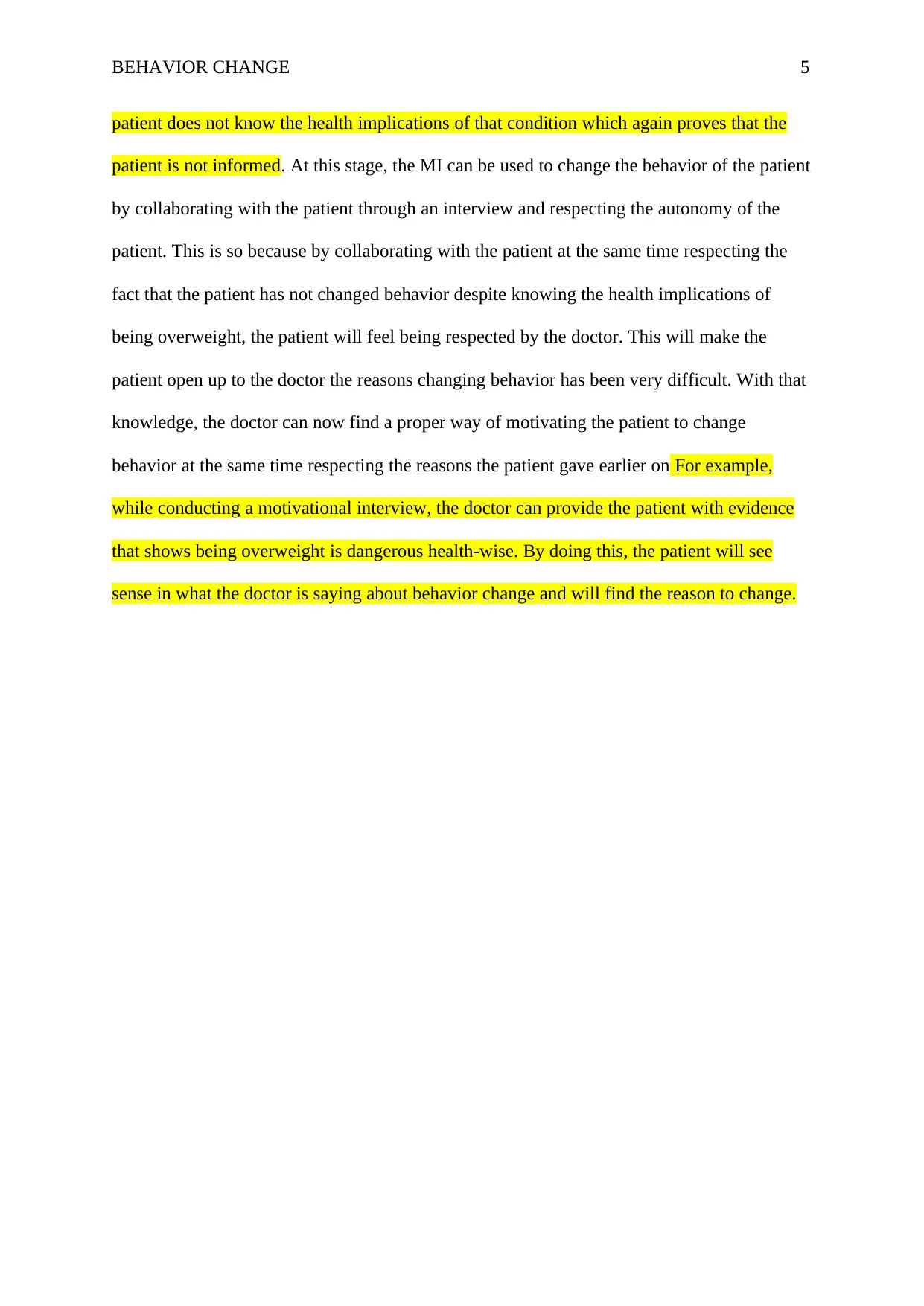
BEHAVIOR CHANGE 5
patient does not know the health implications of that condition which again proves that the
patient is not informed. At this stage, the MI can be used to change the behavior of the patient
by collaborating with the patient through an interview and respecting the autonomy of the
patient. This is so because by collaborating with the patient at the same time respecting the
fact that the patient has not changed behavior despite knowing the health implications of
being overweight, the patient will feel being respected by the doctor. This will make the
patient open up to the doctor the reasons changing behavior has been very difficult. With that
knowledge, the doctor can now find a proper way of motivating the patient to change
behavior at the same time respecting the reasons the patient gave earlier on For example,
while conducting a motivational interview, the doctor can provide the patient with evidence
that shows being overweight is dangerous health-wise. By doing this, the patient will see
sense in what the doctor is saying about behavior change and will find the reason to change.
patient does not know the health implications of that condition which again proves that the
patient is not informed. At this stage, the MI can be used to change the behavior of the patient
by collaborating with the patient through an interview and respecting the autonomy of the
patient. This is so because by collaborating with the patient at the same time respecting the
fact that the patient has not changed behavior despite knowing the health implications of
being overweight, the patient will feel being respected by the doctor. This will make the
patient open up to the doctor the reasons changing behavior has been very difficult. With that
knowledge, the doctor can now find a proper way of motivating the patient to change
behavior at the same time respecting the reasons the patient gave earlier on For example,
while conducting a motivational interview, the doctor can provide the patient with evidence
that shows being overweight is dangerous health-wise. By doing this, the patient will see
sense in what the doctor is saying about behavior change and will find the reason to change.
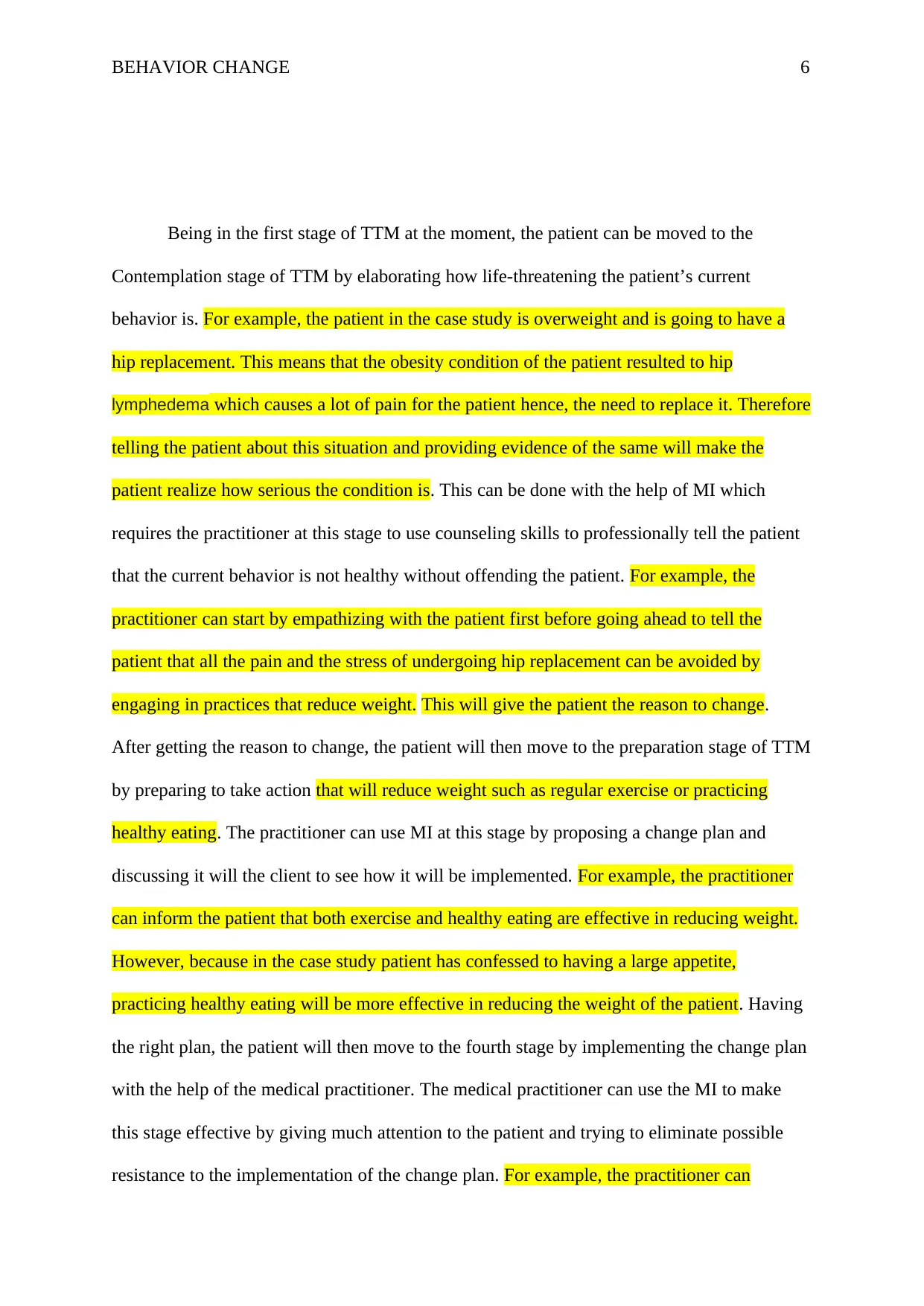
BEHAVIOR CHANGE 6
Being in the first stage of TTM at the moment, the patient can be moved to the
Contemplation stage of TTM by elaborating how life-threatening the patient’s current
behavior is. For example, the patient in the case study is overweight and is going to have a
hip replacement. This means that the obesity condition of the patient resulted to hip
lymphedema which causes a lot of pain for the patient hence, the need to replace it. Therefore
telling the patient about this situation and providing evidence of the same will make the
patient realize how serious the condition is. This can be done with the help of MI which
requires the practitioner at this stage to use counseling skills to professionally tell the patient
that the current behavior is not healthy without offending the patient. For example, the
practitioner can start by empathizing with the patient first before going ahead to tell the
patient that all the pain and the stress of undergoing hip replacement can be avoided by
engaging in practices that reduce weight. This will give the patient the reason to change.
After getting the reason to change, the patient will then move to the preparation stage of TTM
by preparing to take action that will reduce weight such as regular exercise or practicing
healthy eating. The practitioner can use MI at this stage by proposing a change plan and
discussing it will the client to see how it will be implemented. For example, the practitioner
can inform the patient that both exercise and healthy eating are effective in reducing weight.
However, because in the case study patient has confessed to having a large appetite,
practicing healthy eating will be more effective in reducing the weight of the patient. Having
the right plan, the patient will then move to the fourth stage by implementing the change plan
with the help of the medical practitioner. The medical practitioner can use the MI to make
this stage effective by giving much attention to the patient and trying to eliminate possible
resistance to the implementation of the change plan. For example, the practitioner can
Being in the first stage of TTM at the moment, the patient can be moved to the
Contemplation stage of TTM by elaborating how life-threatening the patient’s current
behavior is. For example, the patient in the case study is overweight and is going to have a
hip replacement. This means that the obesity condition of the patient resulted to hip
lymphedema which causes a lot of pain for the patient hence, the need to replace it. Therefore
telling the patient about this situation and providing evidence of the same will make the
patient realize how serious the condition is. This can be done with the help of MI which
requires the practitioner at this stage to use counseling skills to professionally tell the patient
that the current behavior is not healthy without offending the patient. For example, the
practitioner can start by empathizing with the patient first before going ahead to tell the
patient that all the pain and the stress of undergoing hip replacement can be avoided by
engaging in practices that reduce weight. This will give the patient the reason to change.
After getting the reason to change, the patient will then move to the preparation stage of TTM
by preparing to take action that will reduce weight such as regular exercise or practicing
healthy eating. The practitioner can use MI at this stage by proposing a change plan and
discussing it will the client to see how it will be implemented. For example, the practitioner
can inform the patient that both exercise and healthy eating are effective in reducing weight.
However, because in the case study patient has confessed to having a large appetite,
practicing healthy eating will be more effective in reducing the weight of the patient. Having
the right plan, the patient will then move to the fourth stage by implementing the change plan
with the help of the medical practitioner. The medical practitioner can use the MI to make
this stage effective by giving much attention to the patient and trying to eliminate possible
resistance to the implementation of the change plan. For example, the practitioner can
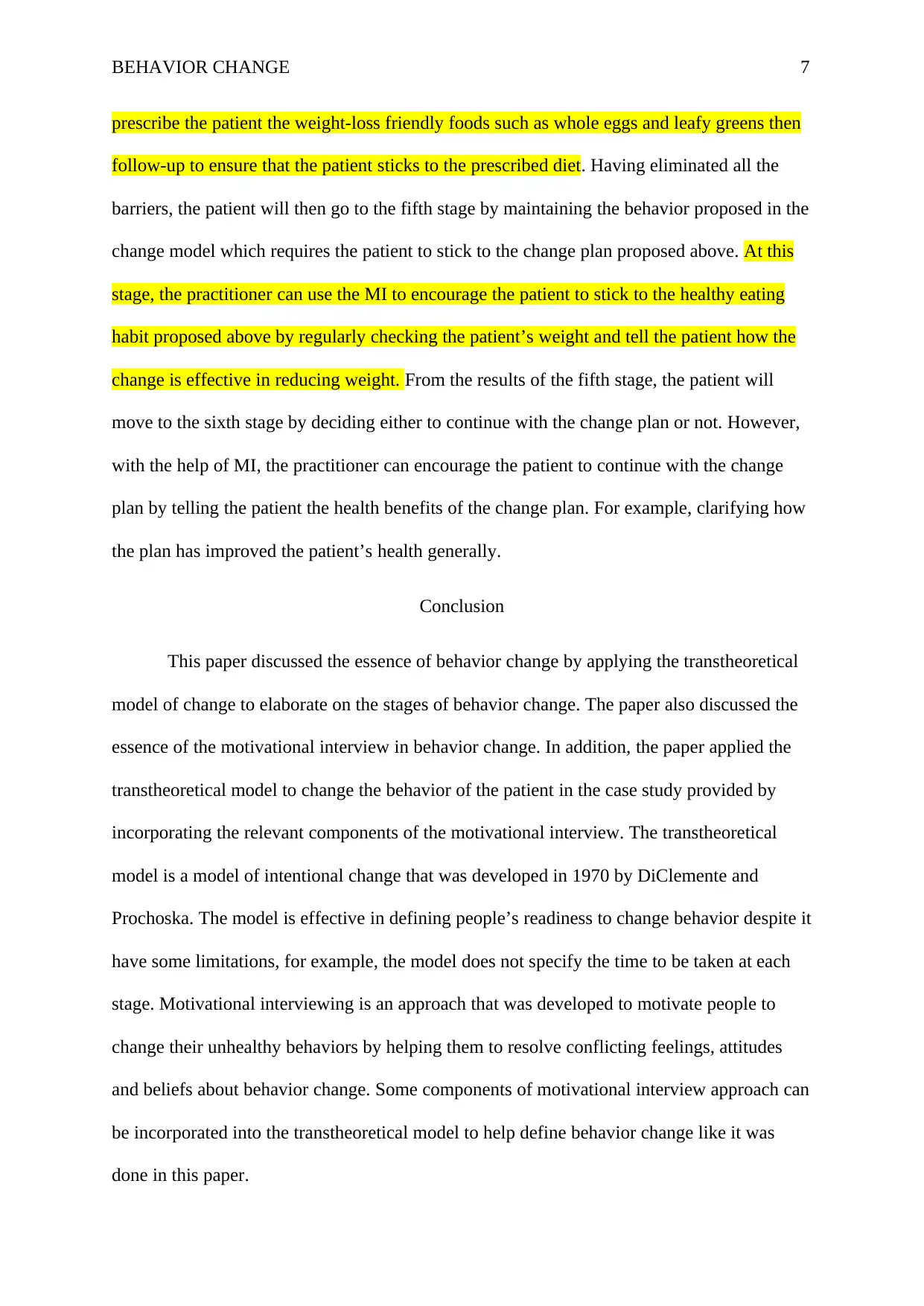
BEHAVIOR CHANGE 7
prescribe the patient the weight-loss friendly foods such as whole eggs and leafy greens then
follow-up to ensure that the patient sticks to the prescribed diet. Having eliminated all the
barriers, the patient will then go to the fifth stage by maintaining the behavior proposed in the
change model which requires the patient to stick to the change plan proposed above. At this
stage, the practitioner can use the MI to encourage the patient to stick to the healthy eating
habit proposed above by regularly checking the patient’s weight and tell the patient how the
change is effective in reducing weight. From the results of the fifth stage, the patient will
move to the sixth stage by deciding either to continue with the change plan or not. However,
with the help of MI, the practitioner can encourage the patient to continue with the change
plan by telling the patient the health benefits of the change plan. For example, clarifying how
the plan has improved the patient’s health generally.
Conclusion
This paper discussed the essence of behavior change by applying the transtheoretical
model of change to elaborate on the stages of behavior change. The paper also discussed the
essence of the motivational interview in behavior change. In addition, the paper applied the
transtheoretical model to change the behavior of the patient in the case study provided by
incorporating the relevant components of the motivational interview. The transtheoretical
model is a model of intentional change that was developed in 1970 by DiClemente and
Prochoska. The model is effective in defining people’s readiness to change behavior despite it
have some limitations, for example, the model does not specify the time to be taken at each
stage. Motivational interviewing is an approach that was developed to motivate people to
change their unhealthy behaviors by helping them to resolve conflicting feelings, attitudes
and beliefs about behavior change. Some components of motivational interview approach can
be incorporated into the transtheoretical model to help define behavior change like it was
done in this paper.
prescribe the patient the weight-loss friendly foods such as whole eggs and leafy greens then
follow-up to ensure that the patient sticks to the prescribed diet. Having eliminated all the
barriers, the patient will then go to the fifth stage by maintaining the behavior proposed in the
change model which requires the patient to stick to the change plan proposed above. At this
stage, the practitioner can use the MI to encourage the patient to stick to the healthy eating
habit proposed above by regularly checking the patient’s weight and tell the patient how the
change is effective in reducing weight. From the results of the fifth stage, the patient will
move to the sixth stage by deciding either to continue with the change plan or not. However,
with the help of MI, the practitioner can encourage the patient to continue with the change
plan by telling the patient the health benefits of the change plan. For example, clarifying how
the plan has improved the patient’s health generally.
Conclusion
This paper discussed the essence of behavior change by applying the transtheoretical
model of change to elaborate on the stages of behavior change. The paper also discussed the
essence of the motivational interview in behavior change. In addition, the paper applied the
transtheoretical model to change the behavior of the patient in the case study provided by
incorporating the relevant components of the motivational interview. The transtheoretical
model is a model of intentional change that was developed in 1970 by DiClemente and
Prochoska. The model is effective in defining people’s readiness to change behavior despite it
have some limitations, for example, the model does not specify the time to be taken at each
stage. Motivational interviewing is an approach that was developed to motivate people to
change their unhealthy behaviors by helping them to resolve conflicting feelings, attitudes
and beliefs about behavior change. Some components of motivational interview approach can
be incorporated into the transtheoretical model to help define behavior change like it was
done in this paper.
Paraphrase This Document
Need a fresh take? Get an instant paraphrase of this document with our AI Paraphraser
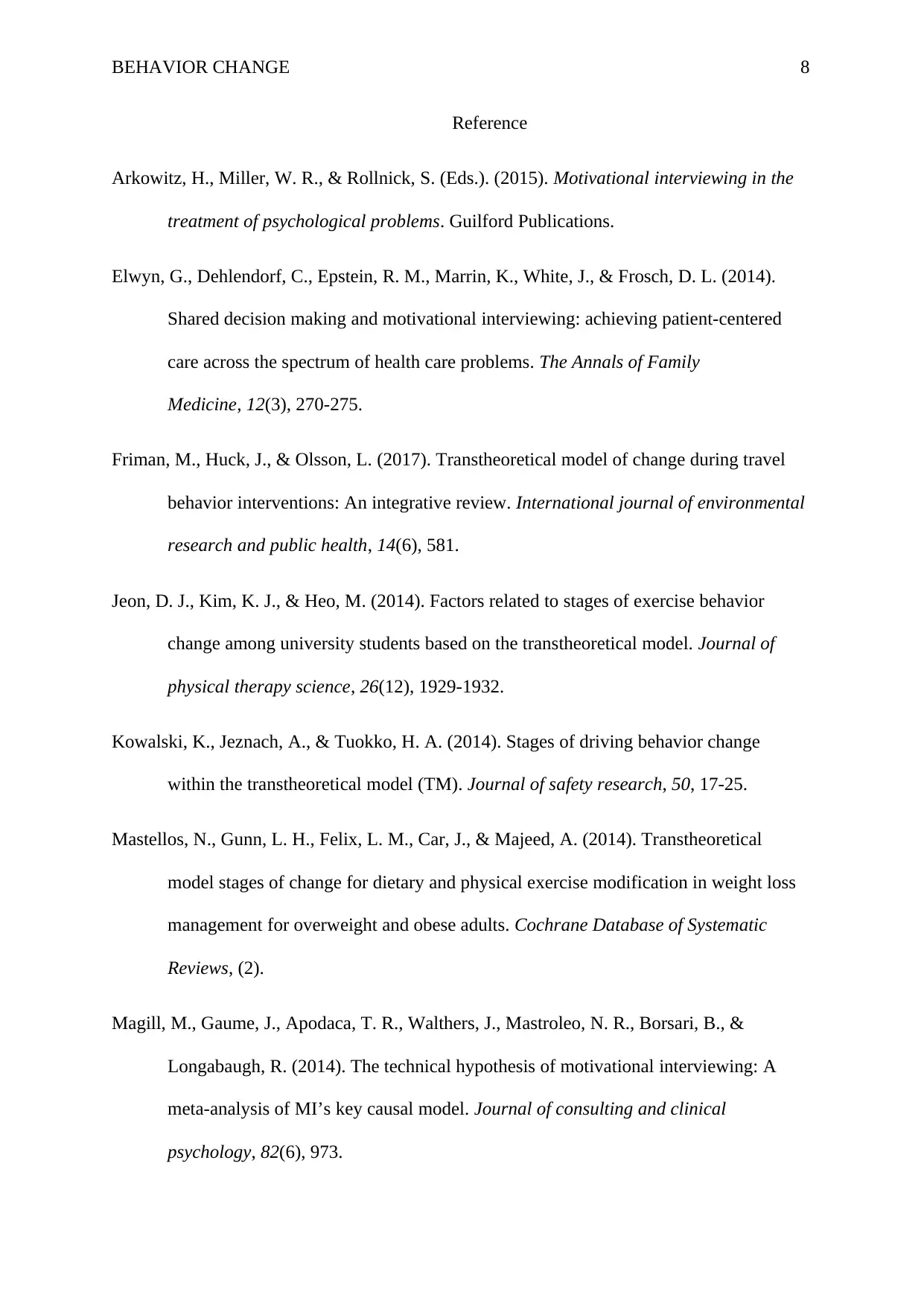
BEHAVIOR CHANGE 8
Reference
Arkowitz, H., Miller, W. R., & Rollnick, S. (Eds.). (2015). Motivational interviewing in the
treatment of psychological problems. Guilford Publications.
Elwyn, G., Dehlendorf, C., Epstein, R. M., Marrin, K., White, J., & Frosch, D. L. (2014).
Shared decision making and motivational interviewing: achieving patient-centered
care across the spectrum of health care problems. The Annals of Family
Medicine, 12(3), 270-275.
Friman, M., Huck, J., & Olsson, L. (2017). Transtheoretical model of change during travel
behavior interventions: An integrative review. International journal of environmental
research and public health, 14(6), 581.
Jeon, D. J., Kim, K. J., & Heo, M. (2014). Factors related to stages of exercise behavior
change among university students based on the transtheoretical model. Journal of
physical therapy science, 26(12), 1929-1932.
Kowalski, K., Jeznach, A., & Tuokko, H. A. (2014). Stages of driving behavior change
within the transtheoretical model (TM). Journal of safety research, 50, 17-25.
Mastellos, N., Gunn, L. H., Felix, L. M., Car, J., & Majeed, A. (2014). Transtheoretical
model stages of change for dietary and physical exercise modification in weight loss
management for overweight and obese adults. Cochrane Database of Systematic
Reviews, (2).
Magill, M., Gaume, J., Apodaca, T. R., Walthers, J., Mastroleo, N. R., Borsari, B., &
Longabaugh, R. (2014). The technical hypothesis of motivational interviewing: A
meta-analysis of MI’s key causal model. Journal of consulting and clinical
psychology, 82(6), 973.
Reference
Arkowitz, H., Miller, W. R., & Rollnick, S. (Eds.). (2015). Motivational interviewing in the
treatment of psychological problems. Guilford Publications.
Elwyn, G., Dehlendorf, C., Epstein, R. M., Marrin, K., White, J., & Frosch, D. L. (2014).
Shared decision making and motivational interviewing: achieving patient-centered
care across the spectrum of health care problems. The Annals of Family
Medicine, 12(3), 270-275.
Friman, M., Huck, J., & Olsson, L. (2017). Transtheoretical model of change during travel
behavior interventions: An integrative review. International journal of environmental
research and public health, 14(6), 581.
Jeon, D. J., Kim, K. J., & Heo, M. (2014). Factors related to stages of exercise behavior
change among university students based on the transtheoretical model. Journal of
physical therapy science, 26(12), 1929-1932.
Kowalski, K., Jeznach, A., & Tuokko, H. A. (2014). Stages of driving behavior change
within the transtheoretical model (TM). Journal of safety research, 50, 17-25.
Mastellos, N., Gunn, L. H., Felix, L. M., Car, J., & Majeed, A. (2014). Transtheoretical
model stages of change for dietary and physical exercise modification in weight loss
management for overweight and obese adults. Cochrane Database of Systematic
Reviews, (2).
Magill, M., Gaume, J., Apodaca, T. R., Walthers, J., Mastroleo, N. R., Borsari, B., &
Longabaugh, R. (2014). The technical hypothesis of motivational interviewing: A
meta-analysis of MI’s key causal model. Journal of consulting and clinical
psychology, 82(6), 973.
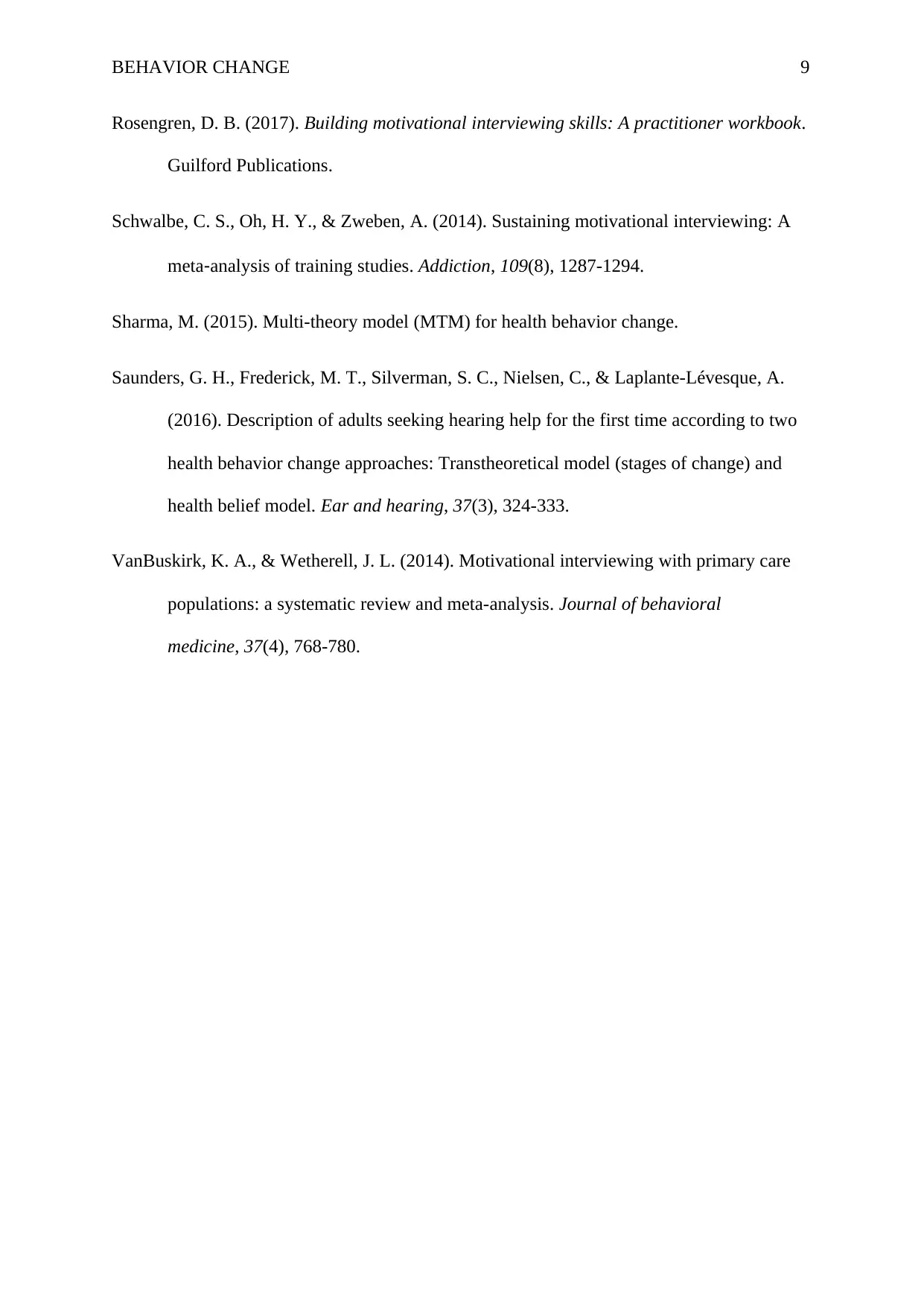
BEHAVIOR CHANGE 9
Rosengren, D. B. (2017). Building motivational interviewing skills: A practitioner workbook.
Guilford Publications.
Schwalbe, C. S., Oh, H. Y., & Zweben, A. (2014). Sustaining motivational interviewing: A
meta‐analysis of training studies. Addiction, 109(8), 1287-1294.
Sharma, M. (2015). Multi-theory model (MTM) for health behavior change.
Saunders, G. H., Frederick, M. T., Silverman, S. C., Nielsen, C., & Laplante-Lévesque, A.
(2016). Description of adults seeking hearing help for the first time according to two
health behavior change approaches: Transtheoretical model (stages of change) and
health belief model. Ear and hearing, 37(3), 324-333.
VanBuskirk, K. A., & Wetherell, J. L. (2014). Motivational interviewing with primary care
populations: a systematic review and meta-analysis. Journal of behavioral
medicine, 37(4), 768-780.
Rosengren, D. B. (2017). Building motivational interviewing skills: A practitioner workbook.
Guilford Publications.
Schwalbe, C. S., Oh, H. Y., & Zweben, A. (2014). Sustaining motivational interviewing: A
meta‐analysis of training studies. Addiction, 109(8), 1287-1294.
Sharma, M. (2015). Multi-theory model (MTM) for health behavior change.
Saunders, G. H., Frederick, M. T., Silverman, S. C., Nielsen, C., & Laplante-Lévesque, A.
(2016). Description of adults seeking hearing help for the first time according to two
health behavior change approaches: Transtheoretical model (stages of change) and
health belief model. Ear and hearing, 37(3), 324-333.
VanBuskirk, K. A., & Wetherell, J. L. (2014). Motivational interviewing with primary care
populations: a systematic review and meta-analysis. Journal of behavioral
medicine, 37(4), 768-780.
1 out of 9
Related Documents
Your All-in-One AI-Powered Toolkit for Academic Success.
+13062052269
info@desklib.com
Available 24*7 on WhatsApp / Email
![[object Object]](/_next/static/media/star-bottom.7253800d.svg)
Unlock your academic potential
© 2024 | Zucol Services PVT LTD | All rights reserved.





